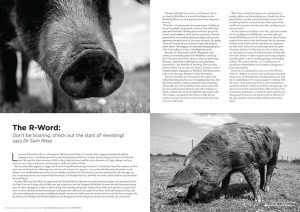
Last week I found myself on a characteristic British summer’s day of fog and mizzle, gingerly treading through the undergrowth of a rewilding area with a good friend, trying to find any of three Tamworth pigs we knew to inhabit the area. We tried the silent treatment (shhh, so they don’t run away) and the noisy alternative of claps, whoops and even snorts to see if they would come and investigate, neither of which worked!
Sad that they didn’t appear, yet happy that I wasn’t being filmed snorting in the mist, I showed my friend the evidence of their work, the rootled soil, the wallowing sites, and even the remains of a pig nest—yes, in the wild they make themselves nests! Being a town-dweller from up-country, he was initially confused at the ‘destruction’ but then amazed at the role that pigs can play in restoring nature to an impoverished landscape, so I thought that he is probably not alone, and it could be a good subject for an R-Word.
So, pigs. What are they? Well, an expert from the Natural History Museum says that domesticated pigs were introduced from the Near East into Europe about 8,000 years ago, where they met the European Wild Boar. It seems that the Boar were having none of these interlopers, so they set about doing some breeding dominance and by about 3,000 years ago the boar genes had been so successful that all domesticated pigs in Europe were effectively descended from them. From this impressive feat, and with some additional serious gene-meddling by people over the last 3,000 years, the breeds we know and love have emerged, like the Gloucester Old Spot, the British Saddleback, the Mangalitzas (from Hungary) and my elusive friends, the Tamworths.
Having established that most of our domestic breeds are majority Wild Boar, it is worth checking out what Rewilding Britain say so eloquently about these impressive beasties,:
“Wild boar is the quintessential soil ecosystem engineer. It ploughs up the soil in woodlands and grasslands in search of tasty bulbs, tubers, grubs and buried acorns. Breaking up the sward clears space for the seeds of annual wildflowers, shrubs and trees to germinate. Disturbed ground provides warm basking spots for grasshoppers and burrowing opportunities for myriad species of bees, wasps and beetles. By exposing buried seeds, boar provide access to food for hungry birds during the leanest months. Their droppings also spread mycorrhizal fungal spores, which in turn help trees to thrive.” (rewildingbritain.org.uk)
Basically, the Tamworths and the Mangalitzas (and others) are channelling their inner Wild Boar and doing all of this great work where allowed. They are promoting Diversity, supporting seed Dispersal and undertaking Disturbance—the three Ds of rewilding. They are most effective where the area they can roam is extensive, such as Purbeck Heaths (Mangalitzas), Wild Ken Hill (Tamworths), and on our doorstep, Mapperton (also Tamworths).
They are normally also very much in the wild, in that within their large area they are not supplementary fed, they give birth naturally outdoors, and their main interactions with people are with any welfare issues and at end of life, because, without apex predators, and with a tendency to breed, numbers have to be managed through regular culls. This is again a recognition that without a fully natural system, you can’t ‘just leave it’, but it also makes for some very tasty wild bacon.
What these animals also bring is an exciting and very popular addition to the rewilding areas. People love these pseudo-Boars, and the animals themselves seem to like us and be partial to a scratch or two, which makes them excellent for tourism and education alike; just keep an eye on your lunch!
So what about actual Boar in the UK, and areas outside of the rewilding areas? Well, there are both wild and farmed Wild Boar in the UK, the Forest of Dean being a particular hot spot for the feral variety. But the presence of Boar in the wild is divisive and there are arguments on both sides. Nature lovers encourage them as a part of nature, which to be fair, they are, but to others they are destructive of crops and infrastructure. In Italy, they have been known to roam in packs destroying complete vegetable plots, as well as raiding garbage and invading gardens. The reasons for this are a combination of insufficient wild predators and complex management / government policy.
From my own perspective, once we in the UK have more of a balance in nature, more and larger connected wilder areas of wood pasture, woodland and scrub, and the re-establishment of an apex predator—starting with the Lynx—then yup, bring them on. Let’s explore how increased numbers of Boar can inhabit our landscape. For now, however, let’s not punish those that are successful at creating a population, it is hard for them, and they are doing good for nature, but also let’s not be afraid to be the apex predator when needed, and bring home that bacon.




